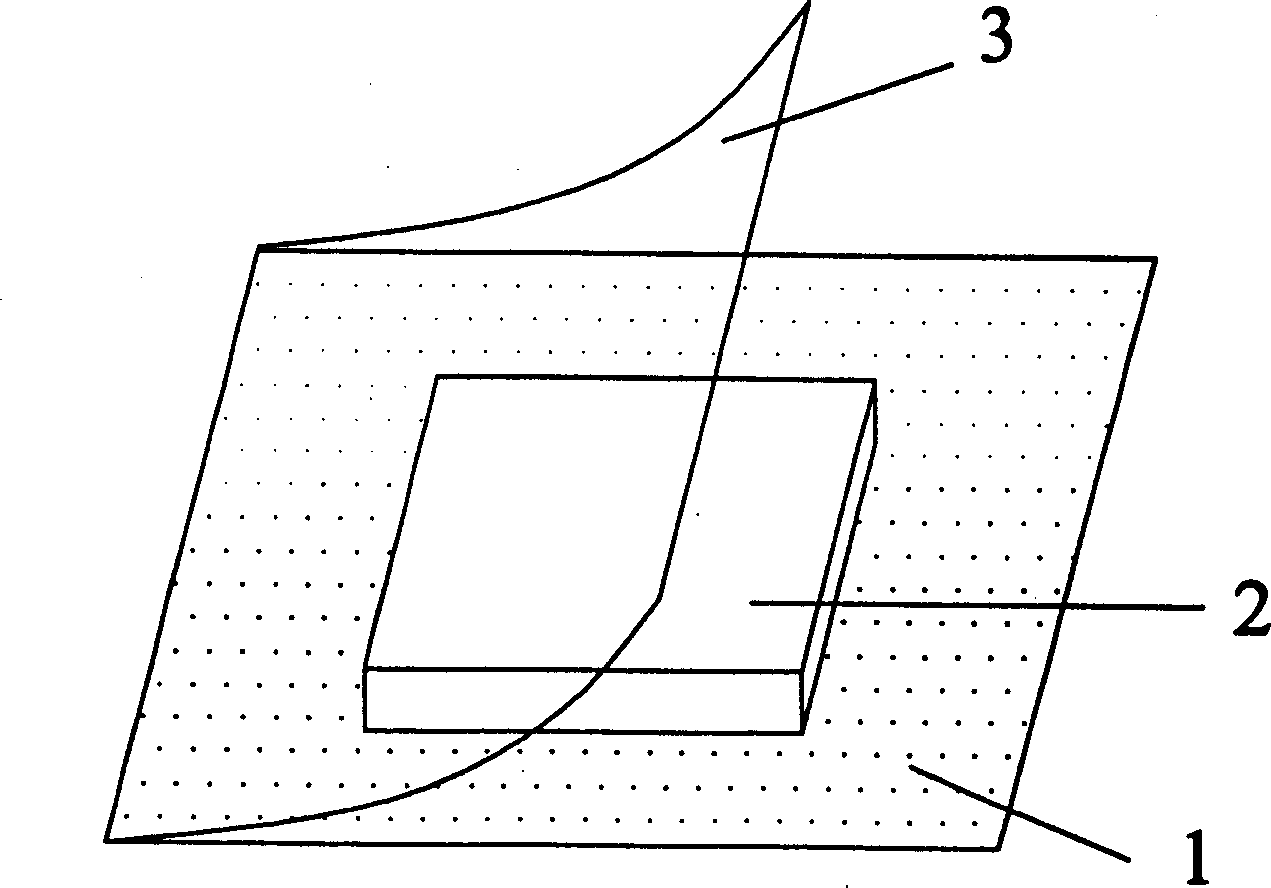Hydrophilic trauma dressing made from polyurethane and its preparation method
A technology of hydrophilic polyurethane and wound dressings, applied in viscous dressings, dressings, medical science, etc., can solve the problems of non-absorbent foam layer and matrix material preparation introduction, etc., achieve good adhesion, no foreign body reaction, and reduce costs Effect
- Summary
- Abstract
- Description
- Claims
- Application Information
AI Technical Summary
Problems solved by technology
Method used
Image
Examples
Embodiment 1
[0047] The structure of polyurethane wound dressing in the present embodiment is as figure 1 As shown, the outer layer 1 and the inner layer 2 are compounded by pressure-sensitive adhesive, the inner layer is polyurethane soft foam slices, and the outer layer is polyurethane film. The preparation method is as follows:
[0048] 1. Preparation of polyurethane soft foam slices
[0049] Raw material formula:
[0050] Polyethylene glycol (molecular weight 1000) 47.25%
[0051] Toluene diisocyanate (TDI-80) 29.04%
[0052] Glycerol 1.97%
[0053]Polyether N210 17.39%
[0054] Stannous octoate 0.87%
[0055] Triethylenediamine 1.16%
[0056] Styrene / acrylonitrile graft polyether alcohol 0.29%
[0057] L-580 Silicone 0.87%
[0058] Deionized water 1.16%
[0059] The above percentages are percentages by weight.
[0060] Technological process: Stir the polyethylene glycol, toluene diisocyanate (TDI-80) and glycerol evenly at room temperature, then heat up to 80°C and react fo...
Embodiment 2
[0071] The structure of polyurethane wound dressing in the present embodiment is as figure 2 As shown, the outer layer 1, the inner layer 2, and the peeling paper 3 are compounded by pressure-sensitive adhesive, the inner layer is a polyurethane soft foam slice, and the outer layer is a polyurethane film. The preparation method is as follows:
[0072] 1. Preparation of polyurethane soft foam slices
[0073] Raw material formula:
[0074] Polyethylene glycol (molecular weight 2000) 49.85%
[0075] Toluene diisocyanate (TDI-80) 27.81%
[0076] Glycerol 2.71%
[0077] Polyether N3010 14.57%
[0078] Stannous octoate 1.19%
[0079] Triethylenediamine 1.19%
[0080] Polybutadiene diol 0.30%
[0081] L-580 Silicone 0.89%
[0082] Deionized water 1.49%
[0083] The above percentages are percentages by weight.
[0084] Process flow: Stir the above polyethylene glycol, toluene diisocyanate (TDI-80) and glycerol at room temperature, then raise the temperature to 85°C and rea...
Embodiment 3
[0097] The structure of polyurethane wound dressing in the present embodiment is as image 3 As shown, the outer layer 1, the inner layer 2, and the release paper 3 are bonded and compounded. The inner layer is polyurethane soft foam slices, and the outer layer is medical adhesive tape or medical non-woven fabric with air holes. The preparation method is as follows:
[0098] 1. Preparation of polyurethane soft foam slices
[0099] Raw material formula:
[0100] Polyethylene glycol (molecular weight 1500) 45.44%
[0101] Toluene diisocyanate (TDI-80) 34.53%
[0102] Glycerol 2.10%
[0103] Polyether N210 12.16%
[0104] Stannous octoate 0.61%
[0105] Triethylenediamine 0.91%
[0106] Polybutadiene diol 0.91%
[0107] L-580 Silicone 1.52%
[0108] Deionized water 1.82%
[0109] The above percentages are percentages by weight.
[0110] Process flow: Stir the above polyethylene glycol, toluene diisocyanate (TDI-80) and glycerin at room temperature, then raise the temp...
PUM
| Property | Measurement | Unit |
|---|---|---|
| Thickness | aaaaa | aaaaa |
| Thickness | aaaaa | aaaaa |
| Thickness | aaaaa | aaaaa |
Abstract
Description
Claims
Application Information
 Login to View More
Login to View More - R&D
- Intellectual Property
- Life Sciences
- Materials
- Tech Scout
- Unparalleled Data Quality
- Higher Quality Content
- 60% Fewer Hallucinations
Browse by: Latest US Patents, China's latest patents, Technical Efficacy Thesaurus, Application Domain, Technology Topic, Popular Technical Reports.
© 2025 PatSnap. All rights reserved.Legal|Privacy policy|Modern Slavery Act Transparency Statement|Sitemap|About US| Contact US: help@patsnap.com



